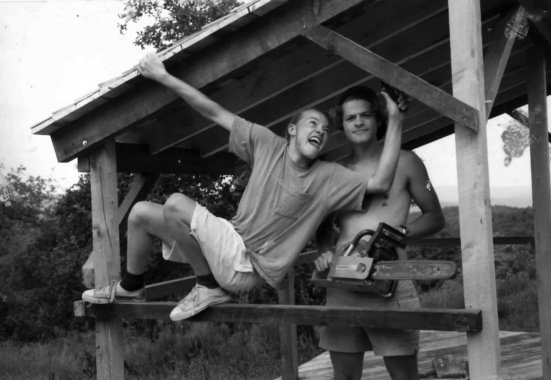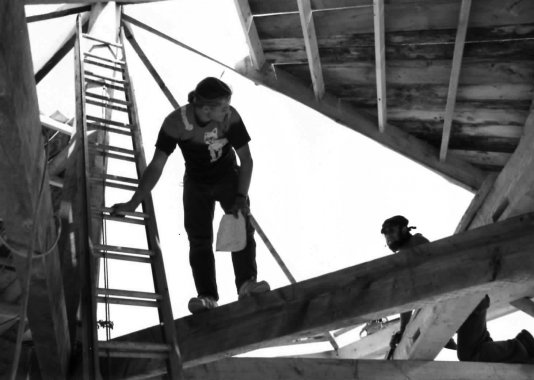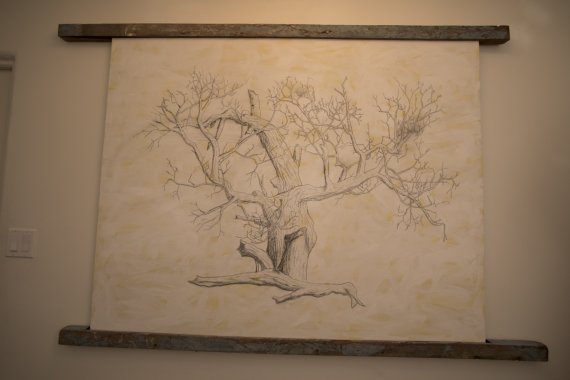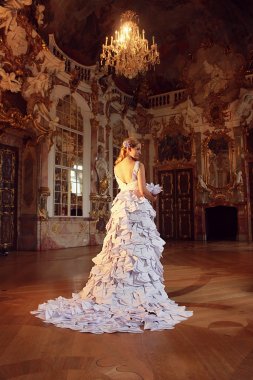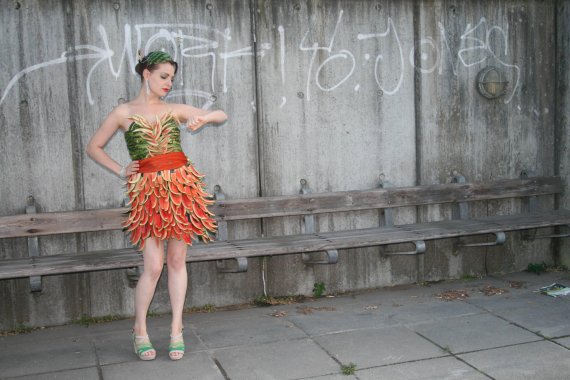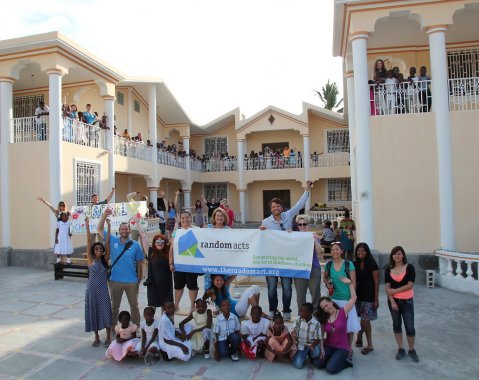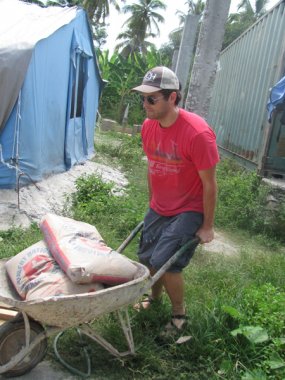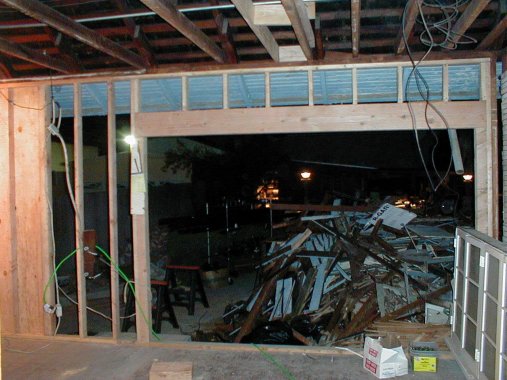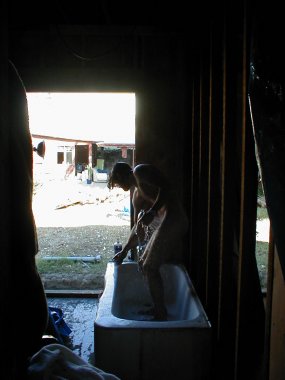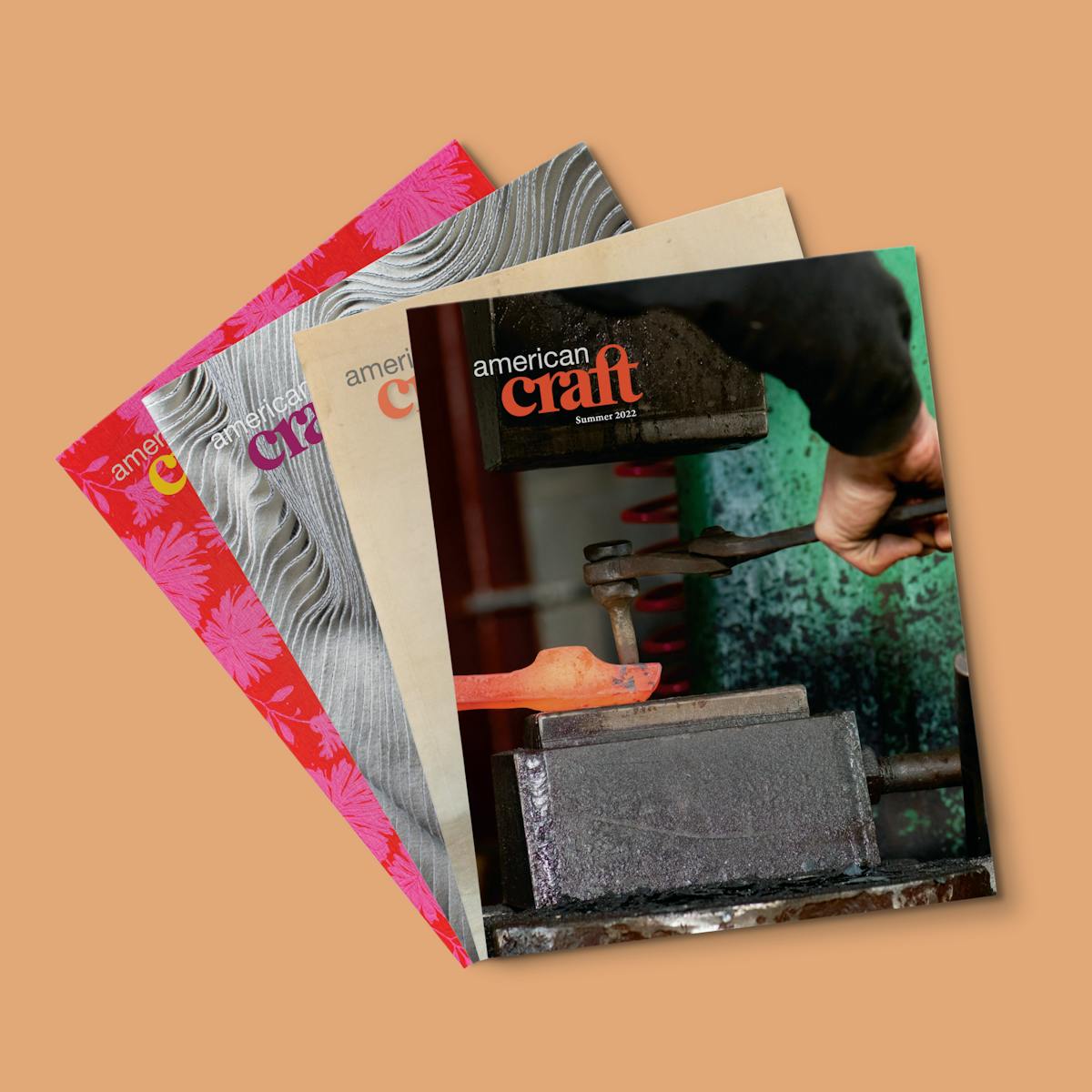Builder, Baker, Angel, Maker
Builder, Baker, Angel, Maker
To fans of Supernatural, the cult TV series now in its 13th season on the CW Network, Misha Collins is known for his powerful portrayal of the angel Castiel, fighting the forces of evil. In real life, he has his own mission for the greater good and plays a more down-to-earth role: skilled craftsman and passionate advocate for handwork.
For Collins, 43, making isn’t just about, say, building a piece of furniture (though he loves doing that). It’s also about making meaning, community, change, happiness, a better world. He’s the founder of Random Acts, a nonprofit dedicated to fostering kindness and good works. To support this endeavor, he runs Gishwhes – the Greatest International Scavenger Hunt the World Has Ever Seen – an annual contest that challenges teams to create wacky, inventive art out of all manner of unlikely stuff.
Craft has been both trade and pastime for Collins since his teens. As a young actor, he bought a rundown bungalow in Los Angeles and rebuilt it from the ground up, making artful use of salvaged materials. He still owns the place, but today lives with his wife, writer Victoria Vantoch, and their two young children in a gracious 1920s Spanish-Moroccan dwelling in the Hollywood Hills. There, too, he has added his own handcrafted detail and imaginatively repurposed objects.
He recently invited American Craft to his two California houses to talk about why making matters. He welcomed us with tea in handmade ceramic mugs.
These mugs are beautiful.
Actually, the friend who made them is Bianca Pulitzer, and she does some really lovely stuff. This is going to sound terrible, but I said to her, “Yeah, there’s a knitting magazine or something that wants to do a piece on me.” She said, “What’s the name of it?” And I said, “American Craft.” And she said, “Oh, American Craft! I have it right here.” It was right on her coffee table, and I picked it up. She was like, “It’s a great magazine.” And it is a great magazine. It’s lovely. I mean – it’s an art magazine.
It is, and that’s something we struggle with a bit.
Well, the term “craft” brings with it associations sometimes. My own prejudices were brought to bear when I heard that name at first.
Anyway, we’re excited to share this side of you. Can you tell us how you started working with your hands, where that passion came from?
Like most kids, I liked making things with my hands, and my mother helped facilitate this when I was pretty young. But I followed that impulse to an apprentice-level devotion. I would seek out woodworkers when I was 10 or 11, going into shops and learning how to use a lathe or – just asking. I grew up in western Massachusetts, and by the time I got into high school I was fully into this – just talking to people and learning things from them in person. A lot of western Massachusetts farmers spend their days by themselves with nobody to talk to, and they were thrilled to have somebody show up and want to learn about their solar wood-drying kiln or whatever. So at an early age I discovered that people were interested in teaching kids things, and I took advantage of that.
Then in high school, I needed a job, so I started doing some manual labor. Our next-door neighbor was a guy named Phil Watson, and he was a colonial style post-and-beam builder. That’s construction where you use mortise and tenon, you do joinery with timbers, posts, and beams to build the house’s frame. The first big thing that I built by myself was a barn. It was really cool, because I started with a chain saw, cutting down the trees in a wooded area that needed to be cleared. I milled every post and beam myself, and cut all of the mortises and tenons with a mallet and a chisel. I still have the mallet that I used in that process – it’s from the late 1800s. Phil, who was my mentor then, told me that you want to get a really old mallet, because the woods they were using to make tools with 100 years ago were old-growth, and that wood is much harder and tighter-grained, so it lasts a lot longer. And it’s true: It’s 100 years old, and it still works great.
I built that barn on my mother’s property. Our house had burned down, so with the insurance proceeds, we built that and a huge post-and-beam structure that Phil was the builder on. That was a really crazy building. We didn’t know if it would come together until the end, because he had all of the designs in his head, not on paper. It was a tetradecahedron, a 14-sided structure.
Then in college I started doing a little bit of furniture building. There’s a bed downstairs that I made as a gift for my girlfriend at the time, wife now. That, and a bench – there’s maple and cherry in both of those. The cherry was from a log we found on our property. The maple was from a big limb of a sugar maple that blew down. I milled that branch up and dried the wood, and then built these two pieces of furniture and a few other things. I love that, taking it from its rawest form – the limb of the tree – all the way through to something finished. It feels like you know the material personally, and then the personal connection to the finished product is much stronger.
How do you think this work affected your development?
A lot of times there’s a bifurcation – people either pursue an intellectual path in their life or they pursue manual arts. I feel grateful to have done both.
You went to the University of Chicago, and you worked through school.
I worked a lot when I was in college, probably 30 hours a week most of the time. I did some handyman stuff, some carpentry stuff. After sophomore year, I took a year off. I interned at the [Clinton] White House, worked at NPR, became an EMT, started a summer camp for kids. It was a great year.
You majored in social theory. So, on one hand you’re in this theoretical world, on the other you’re doing manual labor, working in a concrete way.
I have these photos of myself in my dorm room with an orbital sander, working on stuff, dust everywhere. I’m sure everybody else in the dorm was like, “What the f--- is wrong with that guy?”
After graduation you got into acting, and in 1999, you moved with Victoria to Los Angeles for film and television work. There, in 2001, you bought your first house. Tell us about it. You were a starving actor?
Yeah. Right after we bought it, our realtor said, “There’s a TV show that would like to shoot your house.” They brought this [house-hunting] couple through, and when we saw the episode, they had surveyed the house and were like, “We don’t want to touch this piece of s---.” It was a real wreck, had been seriously neglected. It was built in the 1920s, and built by people who weren’t carpenters, didn’t know what they were doing. It was built so poorly, and everything was sagging – the window frames, the eaves.
Anyway, piece by piece, I rebuilt the whole house. I had an interesting process with it, which was I really tried to salvage and recycle anything I could. For instance, the entire backyard was paved when we moved in. I got this amazing tool, a concrete saw, and I carved up all of the backyard concrete and built these pavers that are wending around the property. All of the windows and doors are salvaged from other places. I milled up redwood to do new siding, which is what would have been on a California bungalow originally.
It was an adventure. While we were building that place, we were living on a shoestring. At the time, there was a carport in the backyard, and we were sleeping under it with these little electric space heaters right next to our heads, outside in the winter. This guy we had met at Home Depot named Carlos who had become homeless – he was helping us remove debris, and he was sleeping wrapped up in fiberglass insulation in the crawl space under the house. It was like this little squatters’ retreat. I have photos of us showering with the garden hose naked in the backyard, which I’m not going to share with you. We’d go across the street to the library to go to the bathroom because we had no working toilet.
The kitchen floor you put in is beautiful.
Yes, that’s gunstock, from a gun manufacturer in Northern California. They had left out these pallets of walnut that were supposed to be used for the handles of rifles or whatever. But they got a little bit of mold on them, and so they weren’t up to standards. It was a huge haul – pallets and pallets, basically a semi [truckload] of walnut – and it was $500. It was such a steal.
On the patio, you put a bit of interactive conceptual art, a vintage snack dispenser. You can get treats like The American Dream, which is the most expensive at $19.99, or Family Obligations –
A group of friends and I did that project. We originally put that out next to a liquor store, out in public. It’s a vending machine, and each of those packets, when you open it up, has a scent. So The American Dream is the smell of fresh-cut grass. Family Obligations is roasting turkey. What are the other labels?
Let’s see. Root Canal . . .
Yeah, that’s like that fake-cherry numbing agent.
You surround yourself with meaning and things you’ve given new life.
I love knowing the story behind something in my environment.
And also things that maybe were tossed or “ugly.”
This is maybe something that motivates me in other realms in life: finding points of poetic interruption. That, I think, happens when there’s an incongruity, or where you discover something unexpected. If you can find beauty in something that is considered refuse or typically discarded as ugly, I think that causes you to have this moment of looking at the world differently and noticing something you hadn’t noticed before. I really love that.
You lived in that first house for 11 years. Do you still own it?
We rent it out to some lovely people who love it, so it’s good.
So this house you’re in now – built in the 1920s?
Yeah, ’20s. This one was actually built well, unlike the other house. I did work with Marne [Dupere, a designer and longtime friend] on this house and we talked through all of these design elements. Like the porch we’re sitting on now – this was part of the inside of the house. It was a major remodel.
You designed this porch ceiling?
I designed the ceiling. Milan [Gelon], a scenic painter from Supernatural, came down, and he brought some beautiful French cheese with him, and he painted this. The idea was to make it look like it was part of the original house.
It’s kind of a Moroccan style.
Yeah, Moroccan. A little bit of Hollywood Moroccan. Moroccan Lite [laughs]. But all of these star shapes in the tiles and windows and on the ceiling – they were not here; we put them in. The cabana my brother, Sasha Krushnic, who’s a builder in Connecticut, and I designed, so I worked on that with him.
On the way to this house, you became very successful with this hugely popular TV series. Life changed. Do you still manage to make time for handwork?
Yeah. I’ve discovered that I really like working. Work can be respite for me, and switching gears is really key. Going from working on scripts to working with my hands is therapeutic, for sure. I am still managing to work with my hands. I was just doing some woodworking yesterday. I do a lot of cooking. That’s a big part of my life, and also I think a barometer of emotional health. When I’m not cooking, it’s a sign that I’m too stressed out and I’ve got to dial things back a little bit. I do a lot of canning. I put up 120 jars of blackberry jam this fall.
Does making inform your acting, and vice versa?
More than informing, it creates a balance in my life. It’s a counterpoint, a different part of my brain. When I can just sort of shift into – you know, canning mode, for instance. Or knitting – I like to knit. It’s meditative, you know? And it does help you turn off the thinking mind and just sink into the animal body.
Is there a fundamental idea of craft that you bring to all of your creative work?
For me, craft is a thoughtfulness that goes into the creation. And I personally like to make things when it feels like that moment in time when that thing wants to be made. I knew I wanted to build a koi pond, and I knew exactly what I wanted it to look like. But I waited for about two and a half years to make it, because I just wanted to have that moment when it felt like, ah, right now I want to make that koi pond. And when I did, a friend and I made it in a day and a half. It was just waiting for that right moment to come.
Craft itself, to be genuinely meaningful, has to be thoughtful and kind of contemplative, not just like cranking something out.
Which artists inspire you?
I love Christo and Jeanne Claude, because of the mind-bending scale on which they’ve created things, like they’re rethinking what’s possible. I’m somebody who kind of likes to break rules, to bend rules when appropriate. So I really love Banksy and the irreverence of some of his work. I love Gordon Matta-Clark, because he was actually a fusion of those two things, bending and breaking rules in some of the stuff that he was doing. He would take an old, abandoned building and go in with chain saws and carve these beautiful geometric shapes, use an entire building as a sculpture block – [laughs] without permission. And then go briefly to jail.
There’s another, anonymous group of artists operating in LA contemporarily, and they’re creating really lovely work in the realm of juxtaposition. They did an installation of beautiful, delicate, ephemeral jacaranda blossoms on a concrete factory and on the concrete base of the LA River recently. They took these sites of industrial and urban blight and turned them into things that were delicate and beautiful.
The other two well-known Hollywood woodworker guys are Harrison Ford and Nick Offerman. Have you ever had a chance to talk mortise and tenon with either of them?
I haven’t, but I would relish the opportunity. So if you could just hook me up with them, that would be great.
Have you turned any Supernatural castmates on to craft?
On a set, there’s tons of downtime, a lot of sitting and knitting and crocheting. And I have occasionally been in the mix there. Last year Jensen [Ackles], my co-star, walked up and saw me knitting, and he just looked at me and said, “Really?” But I could tell there was jealousy behind it, more than criticism. So I’ll teach him to knit, and it’ll be fine. We’ll get through this.
We have in our crew – and this is obviously true of many shows – a team of truly expert craftsmen, 120 people who are so unbelievably good at their jobs. Over and over again, I’ve picked the brains of craftsmen in various departments when I’m working on projects.
You portray an angel, a character steeped in a spiritual context. Do you feel there’s an element of spirituality in handwork? (They say Jesus was a carpenter.)
I do. I have been a fairly serious meditator. I’ve done probably 14 or 15 10-day silent retreats, and the Buddhist philosophy definitely influences my life. But the process of working with your hands – it’s a meditative process. Very few things so easily bring you into the present than just working with your hands.
Your creative life takes many forms, encompassing activism and social engagement. Can you talk about Random Acts and Gishwhes, and how it’s all of a piece?
It’s interesting, I hadn’t thought about Random Acts in terms of craft or making, but the truth is, I think there’s definitely an influence there. The first big project we did with Random Acts was we built an orphanage and community center in Haiti. I would not have thought that was a tackle-able enterprise if I didn’t have a background in building.
Our biggest fundraising driver for the projects that we do – like building a school or an orphanage – is we bring folks down in groups of 25 or so to Haiti or to Nicaragua, and they help in the building process. We roll up our sleeves and get our hands dirty.
One of the seeds for Gishwhes was the fact that I had been carrying around in my notebook this list of art projects that I wanted to do for a long time. And I wasn’t really getting any of these things done. I’m checking off one every three years. And so some of the first Gishwhes were just basically assigning people some of these projects. I was like, “You know what? I’m going to have other people do them and see how they turn out.” It’s really gratifying to see these amazing creations that people have made.
As we know, art programs in K-12 public schools these days are in decline, especially shop class, manual arts. How can we nurture creativity in kids, and why is that important?
When I was 9 years old, I had a paper route. One day my younger brother and I were collecting money, and Mr. Haigis answered the door. He started talking to us, and he discovered that our parents were separated, and we didn’t live with our father. In the 1960s, he had run a woodshop for little kids. He had stopped doing it because he got busy with his career. Now he was retired. These two boys show up delivering papers on his front stoop, and it just comes to him: “I’ve got to do the same thing for those kids.” So Mr. Haigis took us in as his, like, surrogate grandchildren. We would go over to his house all the time. He taught us how to work with electric motors and build things with wood in his little shop. He created this playground of crafting for us. That must have been my first exposure to really making things with wood.
I don’t understand how we can be blind to the fact that art is critical to human development. It’s been a part of our history from before we had writing. And yet the powers that be dismiss it, because it’s not easily measurable. I think it’s absolutely tragic.
Do you think young people ought to consider careers in crafts and the building arts?
I do. I think that people should follow their passion. I am often accused of being a pathological optimist. I think that you can make a career out of anything that you devote yourself to. You have to be persistent and not give up. I was a starving actor for at least a decade.
Do you have a dream house in your head that you’d like to design and build?
Yeah. I’m actively pursuing building a sort of art colony where a handful of friends and then potentially guests could come, where we would have a barn, fully equipped with lots of tools, and a ceramics studio and kiln and all of the tools and space to make whatever you want. This is definitely a fantasy. I think it’s also going to happen.
You and Supernatural have this huge, dedicated following. What message would you like to convey to young fans about handwork and creativity?
I go to [fan] conventions, and people do these amazing pencil drawings or needlepoint portraits or mosaics or whatever. I am blown away by the amount of time and attention and creativity that went into creating this fan art. That got me thinking, what else could we create if we pooled our resources and focused them on specific projects? So that ultimately led to the building projects that we’ve done with Random Acts and the massive art projects that Gishwhes has undertaken. So [gestures to his fans] – thanks for the inspiration.
Discover More Inspiring Stories in Our Magazine
Become a member to get a subscription to American Craft magazine and experience the work of artists who are defining the craft movement today.

